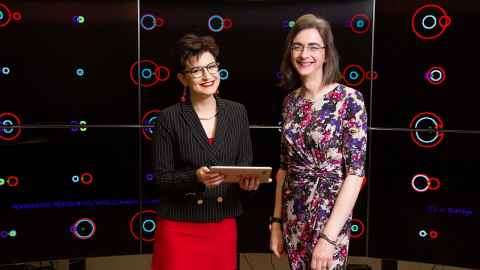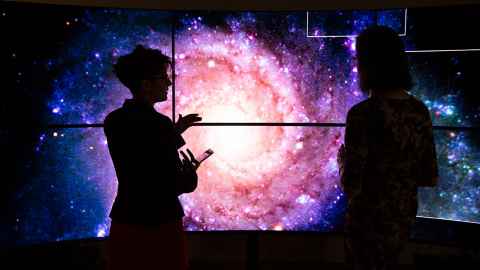Exploding binary stars
9 December 2019
One of New Zealand’s most valuable export fish species is about to take on a new persona in the world of astronomy as the chosen name for a software package that could help unlock some of the secrets of the Universe.

CALLED HOKI BECAUSE it helps “fish through information” about the role of exploding binary stars in the life of our Universe, the computer code has been developed by postdoctoral research fellow Dr Héloïse Stevance who aims to bridge the gap between observations and theory.
“My goal is to write a little piece of software that makes that job very easy and very foolproof for the observer so that they have access to the theoretical code and can compare it to their observations. Focus more on the science and less on the nitty-gritty and the coding – that’s my job.”
Expected to be released in early 2020, Hoki leverages off the Binary Population and Spectral Synthesis (BPASS) codes developed by Héloïse’s fellow astrophysicist, Dr JJ Eldridge, whose pioneering computer models of how stars are born, live and die have caused waves throughout the academic community – and changed assumptions about the evolution of the Universe.
“What my models can predict is what the galaxies will look like at different ages,” JJ says, “and that tells you something about the stars that merged.”
This is where we come from, absolutely. We are made of stardust. That’s what Carl Sagan said – and it is true!
Stellar mergers and binary interactions
Where JJ differs from peers is the acceptance of the fact that most stars in the Universe are born in binary systems, where two stars orbit around each other and sometimes merge, rather than from single stars like the Sun. And BPASS models show that you only need 65-75 percent of the stars previously thought to exist because binaries interact and merge.
“That number of stars is important because it’s how we work out how much stuff is being formed, how many black holes there are, how many neutron stars there are and how many habitable planets there could be. Suddenly if you’re decreasing the number of stars, you’re decreasing all of that in the Universe.”
According to JJ, the reason why single star models were preferred back in the 90s was because binary stars were complicated and potentially involved years of computer time.
“Now we’ve got so much computing power it becomes so much easier and that’s starting to change entrenched views about single star models. Having the computational power to do things that were impossible before is changing people’s minds that maybe we can do things that we couldn’t.”
The BPASS models have also been used to investigate the future and predict what happens to stars 100 billion years from now even though the Universe is currently only 13.7 billion years old. Which raises the age-old question – could there be life forms in other galaxies?
“Will the Universe be more habitable in the future? The answer is probably yes because more of the young stars will die and there’ll be fewer supernovae and nasty things that can kill us,” JJ says.
Supernovae and the origins of life
Another key driver behind their research is the quest to know more about the collapse of stars called supernovae which produce different types of elements – like oxygen and iron – that are crucial to life as we know it. “The oxygen in your lungs right now was created in a supernova, it didn’t come out of nowhere,” says Héloïse. “This is where we come from, absolutely. We are made of stardust. That’s what Carl Sagan said – and it is true!”
The abundance of oxygen and iron has changed over the history of the Universe because it came from different ages of stars that exploded at different times. However, JJ says it’s more difficult to trace the origin of elements like gold, platinum and silver because they came from very rare events such as the neutron star mergers that have led to gravitational waves.
All of which comes back to their current research into gravitational wave events which received fresh impetus in 2017 when the LIGO observatory detected what is known by the purists as GW 170817 – a gravitational wave relatively close to earth that was produced by the dying minutes of two neutron stars spiralling together and finally merging.
Describing it as a violent cataclysmic event which produced “massive fireworks”, Héloïse says that neutron stars involve really “extreme physics” because they consist of a ball around 20 kilometres in diameter and 1.5 times the mass of the Sun with gravity so strong that the surface has virtually no discernible bumps on it.
“The Universe can make it, but how does it do it? And how can we reproduce what the Universe is physically making? Knowing that will tell us a lot about the stars that give rise to the things that we actually observe.”
Funded by a $936,000 Marsden Fund grant, the current focus for JJ and Héloïse is to use the BPASS and Hoki codes to investigate the stars and galaxies associated with the 2017 gravitational wave event by comparing their cosmological simulations with observations from multiple instruments and telescopes.
“The goal is to look at that galaxy and see what we can find with the BPASS models,” says Héloïse. “What can we learn about the stars in that galaxy that people haven’t found with their single star models?”
The Universe can make it, but how does it do it? And how can we reproduce what the Universe is physically making?
Collaboration produces new models
The development of BPASS involves a long-standing collaboration with Associate Professor Elizabeth Stanway from the University of Warwick who JJ has worked with since their PhD days at the University of Cambridge. “She’d been working on galaxies and I’d been working on stars,” says JJ, “and we kind of merged.”
Eighteen years later, Elizabeth remains part of JJ’s gravitational wave project which is also useful because Warwick has a rapid follow up telescope that can track light as quickly as possible. “We can’t do each other’s job, but we understand a lot about what each other does so have been able to make this BPASS code. It’s taken a long time and it is ongoing.”
The collaboration has been deepened by the skills which Héloïse has brought from the UK including a PhD and experience as a part time support astronomer at the Isaac Newton Telescope in Spain. Like Elizabeth, she is a member of the global Engrave collaboration which constantly tracks events like gravitational waves.
For her part, Héloïse is also determined to introduce best practice to her work and has written Hoki in Python which is considered the gold standard of astronomy. In the interests of generating more collaboration, the code will also be fully accessible under an open source licence.
And it seems that a new generation of stargazers is already being inspired to continue the research. Supported by tutorials from Héloïse, Hoki was successfully trialled at a UK summer school where JJ says students quickly embraced a model that would have traditionally taken much longer to understand. “Rather than taking them days or weeks to work out, it took them a few minutes.”
As for their research into the host galaxy of GW 170817, JJ expects to publish something in 2020. They don’t know what they’re going to find but say “we know this is important, we just don’t know how important.”

inSCight
This article appears in the December 2019 edition of inSCight, the print magazine for Faculty of Science alumni. View more articles from inSCight.
Contact inSCight.